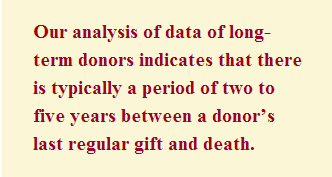If you are responsible for building and maintaining a strong donor base, what should you do when long- term donors suddenly cut back or stop their giving?
Even donors who have been giving regularly for many years normally “downgrade” at some point later in life as they attempt to balance increased living expenses with what may be limited sources of fixed income.
Lower interest rates have cut many fixed incomes in half in recent years impacting current giving by those who are dependent on interest sensitive investments but many older donors still have assets that can be given if the right gift plan is found.
Our analysis of data of long-term donors indicates that there is typically a period of two to five years between a donor’s last regular gift and death. This time period offers a window of opportunity during which you can both honor these donors for their past support and help them continue to give by providing them with alternative gift options that can be better suited to their financial needs.
Recognition with honor
For the appropriate group of older donors with years of giving history, take steps to retain them for a longer period of time or re-establish “family ties” by inviting them to join a recognition group based on their longevity of giving.
Membership in such a group allows them to remain an honored member of your family of donors and gives you an opportunity to provide them with information about gift plans designed for their current financial situation. This may in turn lead to the donor funding a gift that provides income for life or a gift through a will or other gift that takes place at death.
A special list
When forming a recognition society based on longevity of giving, consider limiting membership to donors who are 70 and older (age will vary with the organization) who have made regular gifts for five or 10 years or more.
The goal is to recognize them before they stop giving. The benefits they receive as members will vary by organization but may include periodic news updates, other informative literature or invitations to special events.
You can still solicit contributions from this group, but consider doing so apart from other appeals. By addressing them separately, you can ensure they will continue to receive information about alternative ways to give that will be appealing to them even if they can no longer make current gifts.

Where to begin
An invitation by mail, phone or personal interaction to join the recognition group is the first step. Invitations can be repeated over time as new donors meet the selection criteria. The offer can be made to all those you identify as qualified, but actual membership should be extended only to those who respond affirmatively.
Limiting eligibility to a relatively small group contains the costs of communicating with this group an especially attractive aspect of the project.
Keeping a line of communication open with this special group of lapsed donors provides a response to “I’d like to give, but…” by exploring alternative giving methods. And it may provide an opportunity for long-term donors to continue an established pattern of giving in a way they can manage and enjoy.
Additional gifts over time from donors who may otherwise have lapsed, along with increased bequests and other planned gifts, will more than justify the effort to better steward your longer-term donor population and lead to fruitful and mutually beneficial relationships for years to come.

